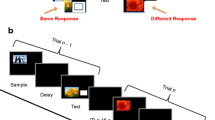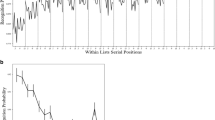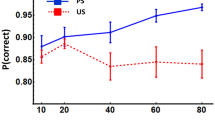Abstract
In this study, we evaluated the effects of diazepam (0.2, 0.8, 1.6 and 3.2 mg/kg; IM) on the primacy and recency memory effects in four rhesus monkeys trained on a six-item serial probe recognition (SPR) task. Only the highest dose of diazepam (3.2 mg/kg) consistently affected the shape of the monkeys' serial position curves. Accuracy on the probe trials was disrupted for list items which occurred in the middle portion and recency memory component of the serial position curve, without affecting the primacy component. Diazepam, however, also produced several nonspecific effects on SPR performance. Both the 1.6 and 3.2 mg/kg diazepam doses disrupted accuracy on the non-matching probe trials, and the 3.2 mg/kg dose caused an increase in response latencies which were unrelated to any one component of the serial position curve. This is the first demonstration in nonhuman primates showing that the primacy and recency memory effects can be differentiated on the basis of diazepam dose.
Similar content being viewed by others
References
Ando K, Johanson CE, Levy DL, Yasillo NJ, Holzman PS, Schuster CR (1983) Effects of phencyclidine, secobarbital and diazepam on eye tracking in rhesus monkeys. Psychopharmacology 81:295–300
Block RI, Berchou R (1994) Alprazolam and lorazepam effects on memory acquisition and retrieval processes. Pharmacol Biochem Behav 20:233–241
Castro CA, Larsen T (1992) Primacy and recency effects in non-human primates. J Exp Psychol [Animal Behav Proc] 18:335–340
Castro CA, Larsen T, Finger AV, Solana RP, McMaster SB (1992) Behavioral efficacy of diazepam against nerve agent exposure in rhesus monkeys. Pharmacol Biochem Behav 41:159–164
Castro CA, Gresham VC, Finger AV, Maxwell DM, Solana RP, Lenz DE, Broomfield CA (1994) Behavioral decrements persist in rhesus monkeys trained on a serial probe recognition task despite protection against soman lethality by butyrylcholinesterase. Neurotoxicol Teratol 16:145–148
Curran HV (1991) Benzodiazepines, memory and mood: a review. Psychopharmacology 105:1–8
Dong T (1972) Probe versus free recall. J Verb Learn Verb Behav 11:654–661
D'Mello GD, Duffy EAM, Miles SS (1985) A conveyor belt task for assessing visuo-motor coordination in the marmoset (Callithrix jacchus): effects of diazepam, chlorpromazine, pentobarbital andd-amphetamine. Psychopharmacology 86:125–131
Ellis NR, Hope R (1968) Memory processes and the serial position curve. J Exp Psychol 77:613–619
Ffaracs AB, Ffaracs AJN, Taylor KM (1983) Comparison of midazolam with thiopentone for outpatient anaesthesia. N Z Med J 96:210–212
Frith CD, Richardson JTE, Samuel M, Crow TJ, McKenna PJ (1984) The effects of intravenous diazepam and hyoscine upon human memory. Q J Exp Psychol 36A:133–144
Ghoneim MM, Mewaldt SP (1975) Effects of diazepam and scopolamine on storage, retrieval and organizational processes in memory. Psychopharmacologia 44:257–262
Ghoneim MM, Mewaldt SP, Berie JL, Hinrichs JV (1981) Memory and performance effects of single and 3-week administration of diazepam. Psychopharmacology 73:147–151
Hanson HM, Witoslawski JJ, Campbell EH (1967) Drug effects in squirrel monkeys trained on a multiple schedule with a punishment contingency. J Exp Anal Behav 10:565–569
Hasegawa Y, Ibuka N, Iwahara S (1973) Effects of chlordiazepoxide upon successive red-green discrimination responses in Japanese monkeys, Macaca fuscata. Psychopharmacologia 30:89–94
Hinrichs JV, Mewaldt SP, Ghoneim MM, Berie JL (1982) Diazepam and learning: assessment of acquisition deficits. Pharmacol Biochem Behav 17:165–170
Hironaka N, Miyata H, Ando K (1992) Effects of psychoactive drugs on short-term memory in rats and rhesus monkeys. Jpn J Pharmacol 59:113–120
Hudzik TJ, Wenger GR (1993) Effects of drugs of abuse and cholinergic agents on delayed matching-to-sample responding in the squirrel monkey. J Pharmacol Exp Ther 265:120–127
Jahnke JC, Erlick DE (1968) Delayed recognition and serial organization of short-term memory. J Exp Psychol 77:641–647
Jitsumori M, Wright AA, Cook RG (1988) Long-term proactive interference and novelty enhancement effects in monkey list memory. J Exp Psychol [Anim Behav Proc] 14:146–154
Jones DM, Lewis MJ, Spriggs TLB (1978) The effects of low doses of diazepam on human performance in group administered tasks. Br J Clin Pharmacol 6:333–337
Jones DM, Jones MEL, Lewis MJ, Spriggs TLB (1979) Drugs and human memory: effects of low doses of nitrazepam and hyoscine on retention. Br J Clin Pharmacol 7:479–483
Lister RG (1985) The amnesic action of benzodiazepines in man. Neurosci Biobehav Rev 9:87–94
Locke WH (1988) Effects of caffeine on mood and memory. Physiol Behav 44:367–372
Lukas SE, Hienz RD, Brady JV (1985) Effects of diazepam and triazolam on auditory and visual thresholds and reaction times in the baboon. Psychopharmacology 87:167–172
Lukey BJ, Corcoran KD, Solana RP (1991) Pharmacokinetics of diazepam intramuscularly administered to Rhesus monkeys. J Pharm Sci 80:918–921
Nicholson AN, Wright CM (1974) Inhibitory and disinhibitory effects of nitrazepam, diazepam and flurazepam hydrochloride on delayed matching behavior in monkeys (Macaca mulatta) Neuropharmacology 13:919–926
Reitan JA, Porter W, Braunstein M (1986) Comparison of psychomotor skills and amnesia after induction of anesthesia with midazolam or thiopental. Anesth Analg 65:933–937
Rich JB, Brown GG (1992) Selective dissociations of sedation and amnesia following ingestion of diazepam. Psychopharmacology 106:346–350
Richardson JTE, Frith CD, Scott E, Crow TJ, Cunningham-Owens D (1984) The effects of intravenous diazepam and hyoscine upon recognition memory. Behav Brain Res 14:193–199
Rupniak NMJ, Samson NA, Steventon MJ, Iversen SD (1991) Induction of cognitive impairment by scopolamine and noncholinergic agents in rhesus monkeys. Life Sci 48:893–899
Sahgal A, Iversen SD (1980) Recognition memory, chlordiazepoxide and rhesus monkeys: some problems and results. Behav Brain Res 1:227–243
Sands SF, Wright AA (1980) Primate memory: retention of serial list items by a rhesus monkey. Science 209:938–40
Schulze GE, Slikker W, Paule MG (1989) Multiple behavioral effects of diazepam in Rhesus monkeys. Pharmacol Biochem Behav 34:29–35
Weingartner HJ, Hommer D, Lister RG, Thompson K, Wolkowitz O (1992) Selective effects of triazolam on memory. Psychopharmacology 106:341–345
Wright AA (1994) Primacy effects in animal memory and human nonverbal memory. Anim Learn Behav 22:219–223
Author information
Authors and Affiliations
Additional information
The opinions and assertions contained in this report are the private views of the author and are not to be construed as official or as reflecting the views of the Army or the Department of Defense. In conducting the research described in this report, the investigators adhered to the Animal Welfare Act and the Guide for the Care and Use of Laboratory Animals, NIH Publication No. 86-23
Rights and permissions
About this article
Cite this article
Castro, C.A. Primacy and recency effects in rhesus monkeys (Macaca mulatta) using a serial probe recognition task I. Effects of diazepam. Psychopharmacology 119, 421–427 (1995). https://doi.org/10.1007/BF02245858
Received:
Revised:
Issue Date:
DOI: https://doi.org/10.1007/BF02245858




